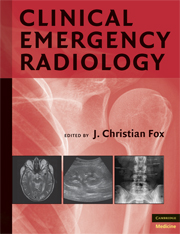Book contents
- Frontmatter
- Contents
- Contributors
- PART I PLAIN RADIOGRAPHY
- PART II ULTRASOUND
- PART III COMPUTED TOMOGRAPHY
- 28 CT in the ED: Special Considerations
- 29 CT of the Spine
- 30 CT Imaging of the Head
- 31 CT Imaging of the Face
- 32 CT of the Chest
- 33 CT of the Abdomen and Pelvis
- 34 CT Angiography of the Chest
- 35 CT Angiography of the Abdominal Vasculature
- 36 CT Angiography of the Head and Neck
- 37 CT Angiography of the Extremities
- PART IV MAGNETIC RESONANCE IMAGING
- Index
- Plate Section
35 - CT Angiography of the Abdominal Vasculature
from PART III - COMPUTED TOMOGRAPHY
Published online by Cambridge University Press: 07 December 2009
- Frontmatter
- Contents
- Contributors
- PART I PLAIN RADIOGRAPHY
- PART II ULTRASOUND
- PART III COMPUTED TOMOGRAPHY
- 28 CT in the ED: Special Considerations
- 29 CT of the Spine
- 30 CT Imaging of the Head
- 31 CT Imaging of the Face
- 32 CT of the Chest
- 33 CT of the Abdomen and Pelvis
- 34 CT Angiography of the Chest
- 35 CT Angiography of the Abdominal Vasculature
- 36 CT Angiography of the Head and Neck
- 37 CT Angiography of the Extremities
- PART IV MAGNETIC RESONANCE IMAGING
- Index
- Plate Section
Summary
INDICATIONS
The progress made by transitioning from axial imaging of soft tissue (with single-detector CT scanners) to volumetric imaging (by multidetector CTs [MDCTs]) has revolutionized vascular studies. Arteries and veins throughout the body can now be visualized in 3D reconstructions and rotated to see an aneurysm's full contour, for example, or visualized in planes to determine the extent of the tear of an arterial dissection. Physicians in multiple specialties are learning to incorporate MDCT-generated vascular studies to see critical lesions — for the oncologist, the technology can clarify the extent of involvement of a cancerous lesion around a vein; the cardiologist obtains, with a brief period of noninvasive imaging, intensely detailed 3D information on coronary vessel plaques and patencies. The emergent use of MDCT angiography (MDCTA) of the abdomen in the ED is in its nascent stages, but promises to be a powerful tool for evaluation of a patient in whom the ED physician suspects a vascular catastrophe. Clots, bleeds, tears, and aneurysms can each represent limb- or life-threatening pathological processes. CT angiography (CTA) of the abdomen can truly alter management and dispositions.
DIAGNOSTIC CAPABILITIES
Aortoiliac System
Leaking or dissecting abdominal aortas, along with similar lesions in the iliac vessels, are among the most anxiety-provoking diagnoses for the emergency medicine physician.
Keywords
- Type
- Chapter
- Information
- Clinical Emergency Radiology , pp. 489 - 496Publisher: Cambridge University PressPrint publication year: 2008

